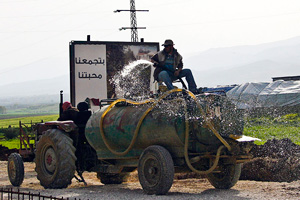
Lebanon faces a number of environmental threats, including air and water pollution, risks associated with climate change, and the impact of the 2006 war with Israel. IRIN takes a look at the top five.
The Mediterranean
Habitat destruction is putting Lebanon’s fishing industry, which according to the UN Food and Agriculture Organization (FAO) accounts for around 6,500 jobs, at risk of collapse if part of Lebanese waters are not designated protected zones in the near future, according to a new Greenpeace report A Network of Marine Reserves In The Coastal Waters of Lebanon.
Greenpeace says 18 designated marine nursery reserves should be created along the Lebanese coastline to replenish endangered fish populations which have been in decline for three decades.
With the prospect of offshore oil and gas exploration (approved by the Lebanese parliament in a new law), Greenpeace warns that “Lebanese coastal waters are also at high risk of accidental spills if exploitation of underwater marine petroleum oil reserves develops in Lebanon.”
Air Pollution
Scientists are warning that pollutants in Beirut’s air have reached concentration levels so high as to become toxic for human health.
Long-term exposure at levels of concentration exceeding 40 micrograms per square metre, according to World Health Organization (WHO) standards, may decrease lung function and increase the risk of respiratory symptoms in humans. According to WHO, levels should be below 20 micrograms per cubic metre to prevent ill health.
While the Mediterranean climate and stagnant air may “trap” toxic gases, the report suggests that 52 percent of the air pollution is from vehicles. Residents of Beirut on average own 2.6 cars.
Climate change
Climate-dependent sectors of the economy in Lebanon such as agriculture and tourism could be affected, according to the 2009 report Rising Temperatures, Rising Tensions, by the International Institute for Sustainable Development.
With 60 percent of Lebanon’s economic activity taking place in a narrow coastal strip along the Mediterranean, it could be susceptible to flooding and erosion as sea levels are predicted to rise. Climate change could also close off previously viable economic activities such as the export of water intensive crops.
Water
Lebanon is the least water scarce country in the Middle East with an annual average rainfall exceeding 800 million cubic metres (mcm), which helps sustain more than 2,000 springs during the seven-month dry season.
However, due to water shortages especially during the dry season the average household in some areas receives under 50 litres per day, which WHO says is the minimum to ensure a healthy environment. It is particularly urban centres, say scientists, that will experience water shortages. Over 80 percent of Lebanon’s population lives in urban areas.
According to experts, the number of rainy days has fallen from 80-90 a year on average 20 years ago to 70. The intensity of the rainfall has correspondingly gone up, meaning less of it seeps into the soil, and more of it runs along the ground, causing soil erosion, landslides, flash floods and ultimately desertification.
Lebanon gets 35 percent of its water from snow. With a rise in temperatures snowfall will decrease and the snowline will rise, according to surveys at the Regional Water and Environment Centre of Saint-Joseph University in Beirut.
War
During the July War of 2006, the largest environmental catastrophe was the bombing of Jiyeh power station causing 15,000 tons of oil to seep into the ocean and affecting 150km of the Lebanese coastline as well as parts of Syria’s coast.
According to the UN Environment Programme (UNEP) 2007 Post-Conflict Environmental Assessment report, “the environmental legacy of conflict is broadly similar with environmental and health issues linked to toxic or hazardous ashes, oils, heavy metals, industrial chemicals, rubble, solid waste and sewage. These may pose health risks to clean-up workers, local communities and at several sites have the potential to leak into water supplies unless sites are thoroughly decontaminated and the pollution contained.”
Leave a Reply
You must be logged in to post a comment.